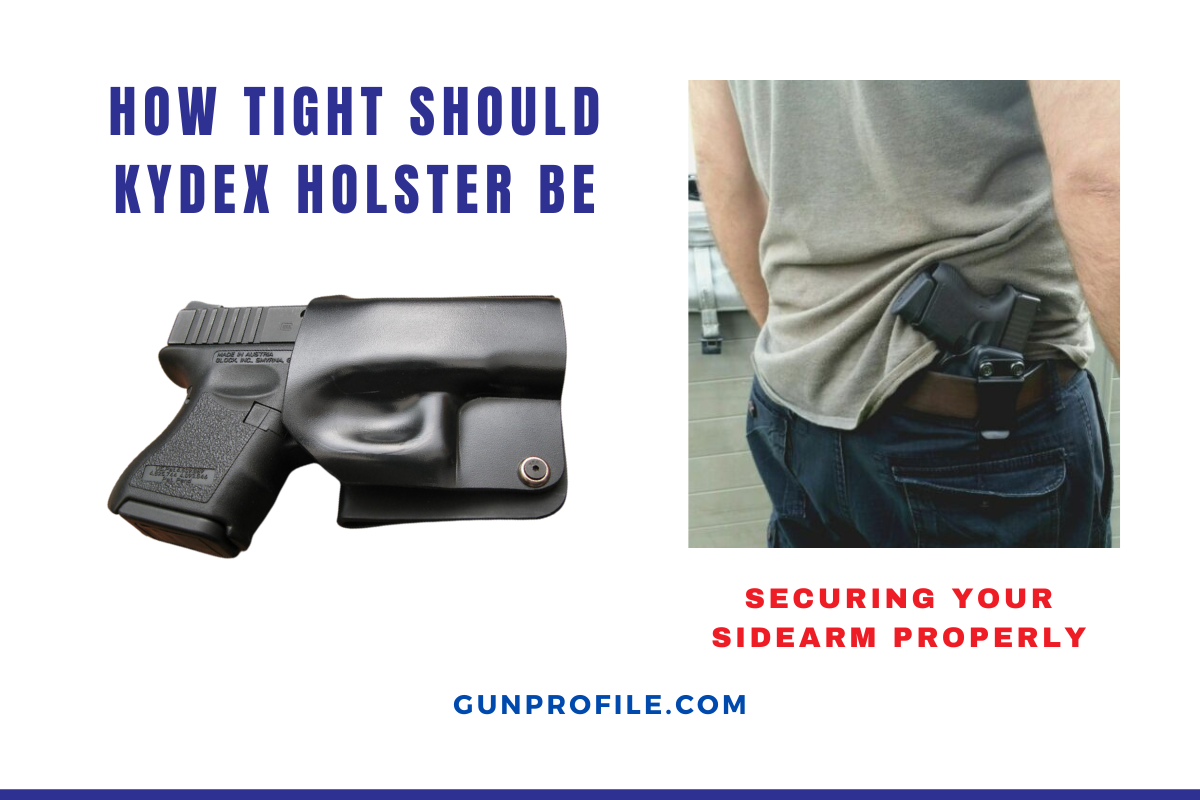Choosing the appropriate level of tightness for a kydex holster is crucial for both the security of your pistol and ease of access when needed. Kydex, being a moldable thermoplastic, is favored for its sturdy form-fitting design, which securely holds the firearm in place. However, if the holster is too tight, it can impede a swift draw, causing delays in critical moments. Conversely, a holster that’s too loose may not retain the pistol adequately, increasing the risk of it falling out or being taken.
To achieve the right balance, it’s essential to understand how kydex reacts to temperature changes and the role of retention adjustment features on your holster. The way a holster fits can also have a significant impact on its performance and the wearer’s comfort. While the retention should be firm enough to keep the firearm secure, it should also allow for a smooth draw without excessive resistance. Knowing how to fine-tune the tightness to suit individual preferences and carrying styles can greatly enhance the functionality and reliability of your kydex holster.
Key Takeaways
- A kydex holster’s tightness affects both the security of the firearm and accessibility.
- Proper retention ensures the pistol remains securely holstered without impeding draw speed.
- Adjusting the holster to individual preferences enhances performance and comfort.
Kydex and Its Properties
Kydex is a thermoplastic material favored for its durability and versatility in the creation of holsters. It offers a balance of toughness and moldability that sets it apart from traditional materials like leather.
The Basics of Kydex Material
Kydex is a line of thermoplastic acrylic-polyvinyl chloride materials known for its impact and chemical resistance. It comes in various grades, including the popular Kydex T, which is often chosen for its rigidity and excellent forming properties. This material can be molded into precise shapes at a molecular level, which allows it to hold its form even under stress. Thicknesses range from .028 to .250 inches, enabling manufacturers to tailor the level of retention and thickness to the application.
Comparing Kydex to Leather Holsters
Leather holsters have traditionally been valued for their aesthetic and comfort. However, Kydex is preferred in environments where durability and maintenance are a concern. Unlike leather, Kydex does not absorb moisture or require the same level of care. Additionally, holsters made of Kydex offer a more consistent retention and typically allow for a faster draw. Their design can incorporate features such as audible retention ‘clicks,’ signaling that the firearm is properly seated, which is an attribute leather holsters lack.
While leather may age and break in over time, potentially changing the fit of the holster, Kydex maintains its shape and retention qualities throughout its lifespan. Given these properties, Kydex is often the material of choice for tactical and active uses where performance and reliability are paramount.

Holster Retention and Fit
Proper holster retention ensures that a firearm remains securely in place while allowing quick access when needed. The fit of the holster must be precise, conforming to the weapon’s contours without being excessively tight or too loose.
The Role of Retention in Holster Function
Retention is the holster’s ability to hold the firearm securely. A primary contact point for retention is the trigger guard, as it provides a critical balance between security and accessibility. The retention should be firm enough to prevent the firearm from falling out or being taken, but not so tight that it impedes a smooth draw. Some holsters use adjustable retention screws, allowing the user to find the right balance.
How to Check for Proper Holster Fit
One should check the holster fit by ensuring there is no unnecessary movement of the firearm within the holster. Areas to examine include the ejection port and the overall holster fit. A well-fitted holster will have the gun making contact with the holster at established contact points without applying pressure to the ejection port, which could compromise functionality.
- Signs of a Proper Fit:
- The firearm snaps into place with an audible click.
- The gun stays secure when the holster is turned upside down.
- Signs of an Improper Fit:
- The firearm is too loose, resulting in rattling or movement.
- The firearm is too tight, making it difficult to draw.
Adjusting Holster Tightness
The proper tension of a Kydex holster is crucial for both security and ease of draw. Incorrect tension can lead to difficulty in drawing the firearm or unintentional release.
Step-by-Step Adjustment Guide
To achieve the ideal fit for your Kydex holster, one must often use the built-in adjustment features. Most Kydex holsters come with adjustment screws that allow the user to modify the pressure exerted on the weapon. To adjust:
- Locate the retention screws on your holster. These are typically found along the edges.
- Determine the desired tightness. The holster should be tight enough to hold the firearm securely but not so tight that it hinders a smooth draw.
- Turn the screws gently, using a screwdriver. Clockwise turns increase tightness, while counterclockwise turns decrease it.
- Test the fit by gently inserting and removing the firearm. Repeat the adjustments until the desired tension is achieved.
- Conduct a safety check by ensuring the firearm does not fall out when the holster is held upside down.
Using Heat for Minor Adjustments
If the holster lacks screws or you need to make a minor tweak, heat can be a valuable tool.
- Prepare a hair dryer or heat gun. Ensure it is set on low heat to avoid damaging the holster.
- Apply gentle heat to the particular area that requires loosening or tightening for a few seconds.
- While the material is warm, mold it slightly by pressing against it to increase tightness or by stretching it gently to loosen.
- Allow the holster to cool before testing the fit with the unloaded firearm.
Remember, using an oven for holster adjustments is not recommended due to the risk of uneven heating and potential damage to the Kydex. Adjusting a holster is about finding the balance between security and accessibility, and with the right tools, it can be a straightforward process.
Maintaining Your Kydex Holster
Proper maintenance of a Kydex holster extends its lifespan and ensures peak performance. Attention to routine care and addressing wear are essential for keeping the holster in top condition.
Regular Maintenance Tips
- Daily Cleaning: Wipe the holster with a dry cloth to remove dust and residue.
- Weekly Check: Use a damp cloth for a more thorough cleaning, avoiding harsh chemicals.
- Screw Tightness: Regularly check and tighten any loose screws to maintain holster stability and function.
Prevention of Moisture Damage:
To protect the Kydex material from the effects of moisture and humidity, store the holster in a cool, dry place when not in use.
Addressing Issues with Holster Wear
- Scratches and Scuffs: Minor abrasions are typical and can often be buffed out gently with a soft cloth.
Inspection for Cracks:
Routinely inspect the holster for any cracks or deformities, particularly after heavy use or exposure to variable temperatures.
Warranty Consideration:
Refer to the manufacturer’s warranty for guidance on potential replacements or repairs for significant issues beyond regular wear and tear.
Through careful maintenance and regular inspections, they can maintain the integrity and functionality of their Kydex holsters, ensuring they are ready for use whenever needed.
Carry Styles and Holster Selection
When selecting a holster for carrying a firearm, one must consider carry styles and holster compatibility with the gun. Personal preference, concealment, comfort, and ease of access play pivotal roles in choosing the right holster.
Choosing Between IWB and OWB
Inside the Waistband (IWB) holsters offer greater concealment as they are designed to be worn with the gun tucked inside the wearer’s waistband. These holsters rely on the waistband and a belt to secure the weapon close to the body, reducing its visible outline under clothing. The thickness of the holster and belt used are crucial for comfort and ensuring the gun remains secure throughout daily activities.
Outside the Waistband (OWB) holsters allow for a quicker draw since they sit on the outside of the pants, making them a popular choice for open carry or when concealment is not a priority. Given that they are positioned away from the body, OWB holsters typically require a jacket or loose shirt for effective concealment.
Selecting the Right Holster for Your Gun
The selection process for the right holster involves ensuring a snug fit that securely holds the gun without impeding the draw. It is important that the holster matches the specific make and model of the firearm, maintaining retention while allowing for a smooth, unobstructed release.
Hand-crafted and custom-designed holsters can provide a perfect match for the weapon’s contours and personalized attachment points for belts, contributing to an optimal balance between security and accessibility. Users should also consider the material rigidity, as a correctly tensioned Kydex holster will not change shape over time, ensuring consistent performance.
Frequently Asked Questions
Proper adjustment and assessment of a Kydex holster contribute to both safety and convenience. This section addresses common concerns, providing clear and concise answers.
What are the steps to properly adjust the retention on a Kydex holster?
To adjust the retention on a Kydex holster, users typically need to locate the retention screws and turn them clockwise to tighten or counterclockwise to loosen, affecting how securely the firearm is held. Each holster might have slight variances, so referring to the manufacturer’s instructions is best for specific guidance.
Can you explain why my firearm feels loose in its holster and how to fix it?
A firearm may feel loose in its holster if the retention is not properly adjusted. To fix this, tighten the retention screws carefully until the desired level of retention is achieved. Ensure that the firearm can be drawn smoothly without excessive resistance.
What indicators suggest a good fit for a firearm in a Kydex holster?
A good fit for a firearm in a Kydex holster is indicated by the holster securely holding the firearm without rattling or excessive movement while still allowing for a smooth draw. The firearm should sit flush against the holster without gaps.
How does the click sound determine proper retention in Kydex holsters?
The click sound in Kydex holsters often signals that the firearm is properly seated and retained. This audible cue is created when the firearm snaps into place, indicating a snug fit between the holster and the firearm’s trigger guard.
Is there a recommended break-in process for new Kydex holsters?
Some manufacturers recommend a break-in period for new Kydex holsters. This can involve drawing and re-holstering the firearm multiple times in a controlled setting to naturally adjust the retention. Consult the manufacturer’s advice for any specific break-in procedures.
How should a gun belt be worn to ensure optimal holster performance?
A gun belt should be sturdy and fit snugly to provide a stable platform for the Kydex holster. The belt’s thickness and width should be compatible with the holster’s attachment system to avoid shifting and ensure proper positioning of the firearm.

